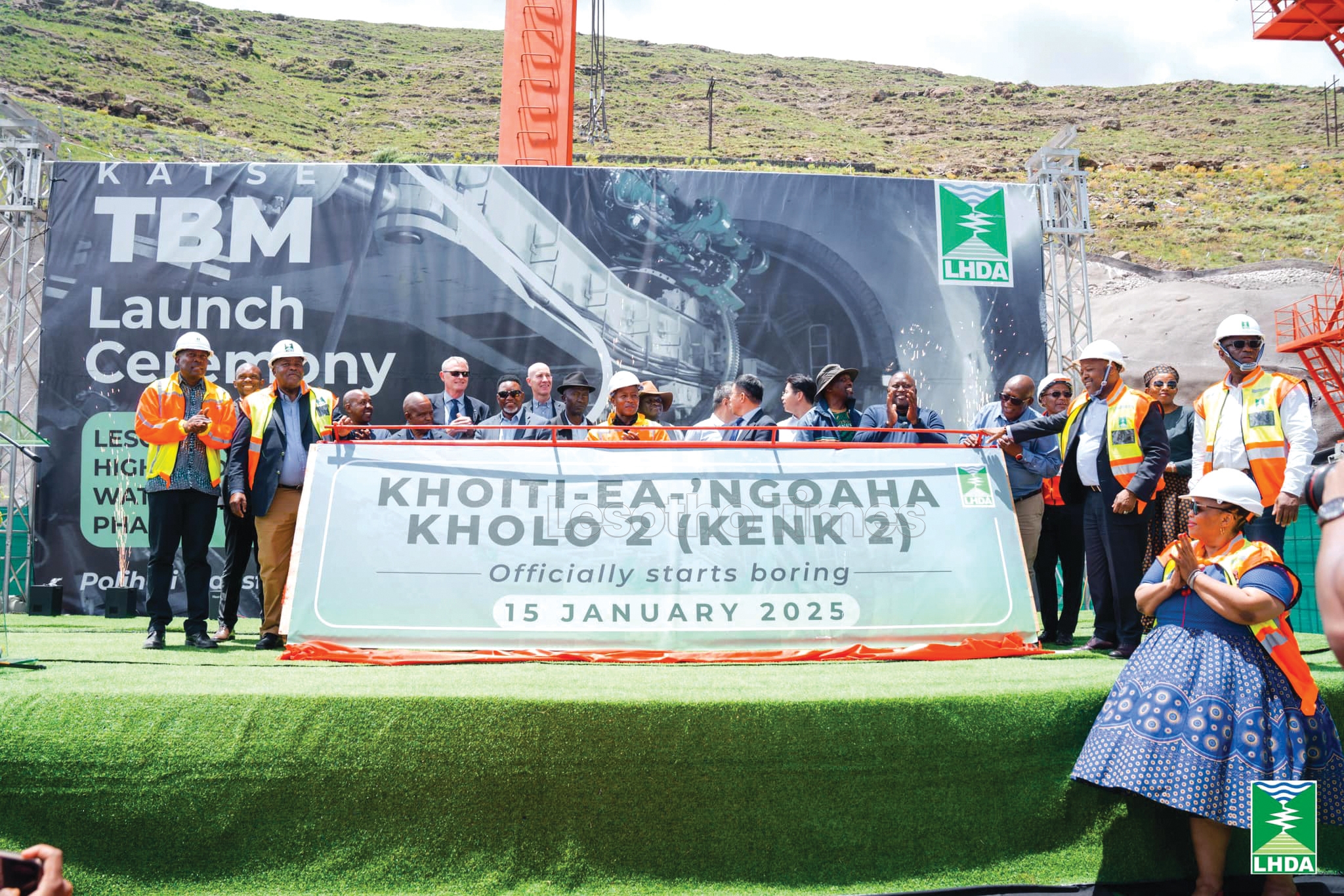…as tunnel boring machine is launched
Leemisa Thuseho
THE Polihali Dam tunnel construction has achieved a significant milestone with the launch of the Tunnel Boring Machine (TBM).
The official launch of the boring machine, held yesterday at Ha-Bereng in Leribe, followed the completion of the assembly of its components, which began in September last year.
This is the first of two double-shielded TBMs designed to excavate the 38-kilometer Polihali Transfer Tunnel from the Leribe side adit as part of the Lesotho Highlands Water Project Phase II (LHWP II).
The second TBM, which will excavate the tunnel from the Polihali side (the Mokhotlong adit), is expected to arrive on site in mid-2025. The tunnel is being excavated using both tunnel boring and drill-and-blast methods at both ends.
The tunnel was designed by MSKC Joint Venture, a consultancy firm overseeing the construction, while the construction contract was awarded to Kopano Ke Matla Joint Venture. The joint venture comprises Yellow River Company, Sinohydro Bureau 3, and Unik Civil Engineering.
The Polihali Transfer Tunnel will enable the gravity-driven transfer of water from the Polihali reservoir to the Katse reservoir. It will facilitate the transfer of 1270 cubic meters of water per second, contributing to meeting the increasing water needs of South Africa’s Gauteng province.
The TBM is set to significantly accelerate the boring process, achieving an excavation rate of 20 meters per day compared to the 7.3 meters per day achieved by the traditional drill-and-blast method.
Chief Executive of the Lesotho Highlands Development Authority (LHDA), Tente Tente, highlighted the importance of this achievement.
“This is a significant milestone for us as the Lesotho Highlands Development Authority (LHDA) and our service providers,” Mr Tente said.
He also said Phase II continued to build on past successes to maximise the economic benefits for both Lesotho and South Africa.
“The project is borne out of the desire to enhance the condition of life for the people of the Kingdom of Lesotho and the Republic of South Africa and promote the traditions of good neighbourly relations and peaceful cooperation between the two countries.”
Mr Tente also shared that Phase II had, to date, created more than 11 000 jobs, injected over M366 million in contracts to small- and medium-sized Basotho businesses, and implemented livelihoods and environmental programs to benefit the communities.
Speaking on behalf of the Prime Minister, Minister of Local Government, Chieftainship, Home Affairs, and Police Lebona Lephema, acknowledged the importance of this milestone in the implementation of Phase II of the LHWP.
He said the construction of Phase II added to the legacy of Phase I by bolstering economic development for both Lesotho and South Africa.
“Since the implementation of the project, we have remained true to our goals as Lesotho and South Africa of bolstering economic development in the Republic of South Africa by facilitating the transfer of water resources for sustainable economic growth, while simultaneously uplifting the economy of Lesotho through the generation of electricity,” Mr Lephema said.
“At the heart of the project is the improvement of the livelihoods of our citizens. It is crucial for LHWP to never overlook the significance of restoring the lives of individuals directly impacted by this project. It is imperative that these individuals are treated with the utmost respect and compassion.”
Minister of Natural Resources, Mohlomi Moleko, echoed similar sentiments, reiterating the enduring collaboration between Lesotho and South Africa.
“The transfer tunnel and other critical infrastructure are not only remarkable achievements in engineering but also a reflection of the enduring friendship and collaboration between Lesotho and South Africa,” Mr Moleko said.
He also said the introduction of the TBM into the construction program represented a profound commitment from both nations to successfully deliver Phase II of the project.
“The traditional construction methods, such as drill-and-blast, were limited to a progress of approximately 3 to 4 meters per day. In stark contrast, this advanced TBM has the capacity to excavate up to 20 or more meters per day.
“This advancement will substantially accelerate the speed of excavation, enabling us to meet our project goals.”
In keeping with the tradition of naming TBMs before operations commence, the LHDA held a naming competition among Basotho. The winning name, Khoiti ea Ngoaha Kholo2—translated as “The Rat Mole of 200 Years”—was submitted by Mary Taolana.
The “2” in the name symbolises the 200th anniversary of Basotho nationhood, marking two centuries of Lesotho’s existence. For her contribution, Taolana was awarded M50 000.



1 comment
Travel in ease with Nassau Airport Shuttle. Shuttle Airport Nassau provides 24/7 services for your convenience. Nassau Shuttle helps you avoid long waits and ensures prompt service.